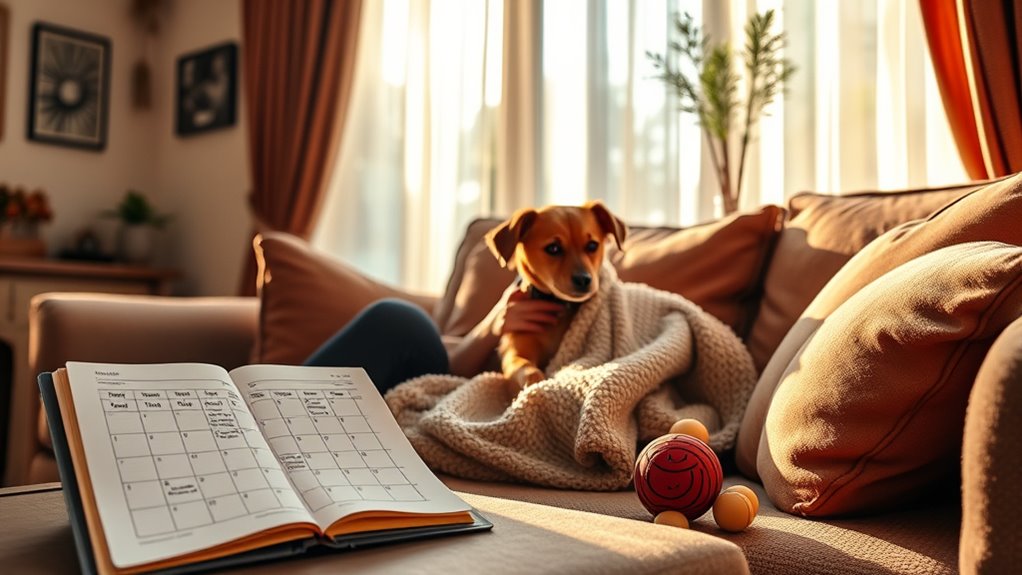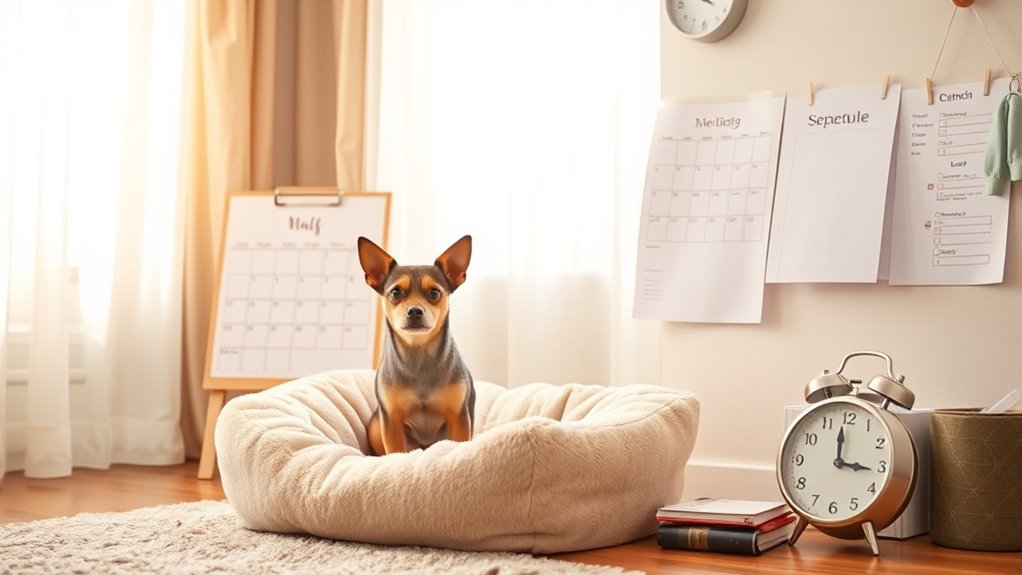To handle separation anxiety effectively, start with short, frequent sessions—just a few seconds to a minute—several times daily, gradually increasing the duration as your pet shows comfort. Increase the time by a few minutes every few days, watching for signs of distress. Keep routines consistent and predictable to build confidence. If you notice signs of anxiety, pause and offer reassurance before continuing. Staying consistent and patient helps your pet feel secure—learn more solutions as you continue this approach.
Key Takeaways
- Start with brief, daily separations of just a few seconds to a minute, gradually increasing over weeks.
- Repeat training sessions multiple times daily to build consistency and reinforce calm behavior.
- Increase separation duration gradually by a few minutes every few days, monitoring your pet’s stress signals.
- Incorporate regular, predictable routines and avoid sudden schedule changes to promote security.
- Pause or adjust training if signs of distress become overwhelming, focusing on positive reinforcement and patience.
Establishing a Consistent Separation Training Schedule

Separation anxiety can be challenging for both pets and their owners, but managing it effectively requires understanding how often to expose your pet to brief separations. The key is to establish a consistent training frequency that gradually builds your pet’s emotional resilience. You don’t want to overwhelm your furry friend, but you also need to prevent them from becoming too dependent or anxious when alone. Finding the right balance involves planning short, controlled absences that slowly increase in duration over time, helping your pet adapt without feeling abandoned.
Start with very brief separations, such as leaving the room for a few seconds or a minute, then return calmly without making a big fuss. Repeat this process multiple times a day, aiming for consistency. The goal is to make your pet realize that your absence is temporary and predictable. Over time, increase the length of these separations gradually—perhaps adding a few minutes every few days—based on your pet’s response. If they show signs of distress, reduce the duration and give them more time to adjust before extending the period again. This steady, incremental approach helps build their emotional resilience and reduces anxiety triggers.
It’s important to remember that training frequency isn’t just about how often you leave; it’s also about how consistently you do it. Regular, predictable practice helps your pet understand that you will return, which can substantially diminish their anxiety over time. If you’re inconsistent, your pet may become more confused and stressed, prolonging the anxiety. Similarly, if you notice your pet becoming overly distressed during a session, it’s best to pause and give them extra reassurance before resuming. Patience is essential—progress may be slow, but persistence will pay off.
Incorporating high-quality training sessions that utilize positive reinforcement during these practices can significantly enhance your pet’s comfort and confidence. When your pet remains calm or copes well during a brief separation, reward them with treats or praise when you return. This reinforces the idea that staying calm during your absence leads to positive outcomes. Remember, every pet is unique, so adapt the training frequency and duration based on their comfort level and emotional resilience. The ultimate goal is to help your pet develop confidence and independence gradually, reducing their separation anxiety and making both your lives easier. Consistency, patience, and understanding are your best tools in this process.
Frequently Asked Questions
Can I Handle Separation Anxiety Daily Without Causing Stress?
Yes, you can handle separation anxiety daily without causing stress by using crate training and calming techniques. Keep sessions short and positive, gradually increasing time apart to build your pet’s confidence. Incorporate calming methods like soothing music or pheromone diffusers. Consistency is key; daily practice helps your pet feel secure without overwhelming them. Always observe their reactions and adjust routines to prevent stress, creating a balanced approach to managing separation anxiety.
How Do I Know if My Pet Is Ready for Longer Absences?
You’ll know your pet is ready for longer absences if they’ve successfully completed crate training and show confidence during socialization. Observe their behavior; if they remain calm and relaxed when alone or in their crate, it’s a good sign. Gradually increase your departure time, watching for signs of stress. Consistent socialization and positive crate experiences build their independence, making longer absences less stressful for both of you.
Should I Increase Handling Frequency if My Pet Shows Progress?
Think of your pet’s progress like a delicate garden—you want steady, consistent care. If you notice positive changes, it’s wise to increase handling frequency gradually, always monitoring their response. Consistent handling builds confidence, but rushing can cause setbacks. Keep tracking their reactions, and adjust your approach based on progress monitoring. This thoughtful balance helps your pet grow more comfortable, turning separation anxiety into a thing of the past.
Is There an Ideal Time of Day for Separation Training Sessions?
You should schedule separation training sessions during consistent times, ideally fitting into your morning routines. Morning sessions work well because your pet is fresh and less anxious, making it easier to build positive associations. Maintaining timing consistency helps your pet anticipate and feel secure during these sessions. Avoid irregular times, as unpredictability can increase anxiety. Stick to a regular schedule to maximize progress and help your pet adapt comfortably.
How Do I Balance Training With My Pet’s Natural Energy Levels?
You should balance training with your pet’s energy levels by observing their natural rhythms—most dogs are most energetic in the morning and evening. Incorporate calming techniques after vigorous exercise to prevent overstimulation. An interesting statistic shows that dogs need about an hour of exercise daily. Use exercise routines to burn off excess energy, then follow up with calming techniques to reinforce calmness and help your pet adapt to separation more easily.
Conclusion
By sticking to a consistent schedule, you’re like a steady lighthouse guiding your pet through separation anxiety. Regular, brief training sessions help build their confidence and reduce stress over time. Remember, patience is key—just like planting a seed and watching it grow, your efforts will pay off. Keep it steady, stay positive, and your pet will learn to feel safe even when you’re not around. Consistency truly lights the way to a calmer, happier pet.










